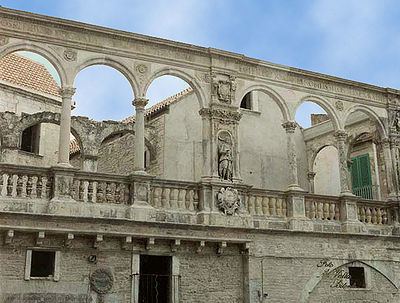Elevation 118 m (387 ft) | Frazioni Mariotto, Palombaio Demonym(s) Bitontini Local time Thursday 11:16 PM | |
 | ||
Weather 9°C, Wind SW at 11 km/h, 75% Humidity Points of interest Bitonto Cathedral, Angevin Tower, Galleria nazionale della Pug, Vulpano Sylos Palace, Palazzo De Ferraris Regna | ||
Bitonto ([biˈtonto]) is a city and comune in the province of Bari (Apulia region), Italy. It is nicknamed the "City of Olives", due to the numerous olive groves surrounding the city.
Contents
- Map of 70032 Bitonto Metropolitan City of Bari Italy
- Geography
- History
- Main sights
- Famous natives
- Economy
- Transportation
- Twin townsSister cities
- References
Map of 70032 Bitonto, Metropolitan City of Bari, Italy
Geography
Bitonto lies approximately 11 kilometres (7 mi) to the west of the city of Bari, near the coast of the Adriatic Sea. The communes next to Bitonto are: Bari, Bitetto, Palo del Colle, Altamura, Toritto, Ruvo di Puglia, Terlizzi, and Giovinazzo.
History
The city was founded by the Peucetii, and its inhabitants referred to by the Greek settlers of the region as Butontinoi, an ethnonym of uncertain derivation. According to one tradition, the city was named after Botone, an Illyrian king. Its first city wall can be dated to the fifth to fourth centuries BC; traces remain in the foundations of the Norman walling.
Similarities of coinage suggest that Bitonto was under the hegemony of Spartan Tarentum, but bearing the numismatic legend BITONTINON. Later, having been a Roman ally in the Samnite Wars, the civitas Butuntinenses became a Roman municipium, preserving its former laws and self-government and venerating its divine protectress, whom the Romans identified by interpretatio romana as Minerva; the site sacred to her is occupied by the Church of San Pietro in Vincoli. As a city of the Late Roman Empire, Bitonto figures in the Liber Colonis of Frontinus, in the Antonine Itinerary and other Imperial itineraries, and the Tabula Peutingeriana, a post where fresh horses were to be had for travellers on the via Traiana for Brundisium.
The foundations of a Paleochristian basilica came to light in excavations beneath the cathedral's crypt, but no written evidence survives of an established diocese in the Early Middle Ages. Though there is no evidence that a Lombard gastaldo had his seat at Bitonto, Lombard customs and law insinuated themselves deeply in local social fabric.
During the ninth century, Bitonto successfully withstood a Saracen raid, in which the besiegers' leader was killed beneath the city's walls Bitonto took part in the revolt of Melus of Bari in 1009.
In the Middle Ages Bitonto was a fief of several baronial families, before it passed permanently in the thirteenth century to the Acquaviva, who took their name from their stronghold at Acquaviva delle Fonti: The Acquaviva were later dukes of Atri, and their minor signory of Bitonto was raised to a marquisate in 1464 by the King of Naples, Ferrante di Aragona in favour of Giovanni Antonio Acquaviva; on his premature death it passed to his brother, the successful and cultivated condottiero Andrea Matteo Acquaviva, who exchanged it in 1487 for the marquessate of Ugento, which he subsequently lost. In 1552 the citizens paid for the city's freedom the considerable sum of 66,000 ducats.
In 1734, during the War of Polish Succession, the Spanish army under Charles of Bourbon and the Duke of Montemar defeated the Austrians under Giuseppe Antonio, Prince of Belmonte at the Battle of Bitonto, thus securing possession of the Kingdom of Naples for the Bourbons.
On September 6, 1928 the village of the Holy Spirit, the only access to the coast and the subject of border disputes between the two cities since the Thirteenth century, it passed to the municipality of Bari. The territory stolen had a surface area of about 16 square kilometers.
Main sights
The city includes a medieval burg and a modern area.
The main landmarks include:
Famous natives
Economy
Bitonto is well known for its production of extra virgin olive oil, which is exported to America and elsewhere in Europe. The city also produces wine, beer, cereals, almonds, and textiles.
Recently, Bitonto has also become a popular tourist destination.
Transportation
Bitonto is not directly connected to the Italian national railway system. However, it is serviced by an electric rail line operated privately by Ferrotramviaria. Bitonto is 8 kilometres (5 miles) away from the international Karol Wojtyła Airport of Bari.
Around Bitonto, there is a ring road looking like a perfect circle from which however the eastmost part is missing [1].
Twin towns—Sister cities
Bitonto is twinned with:
